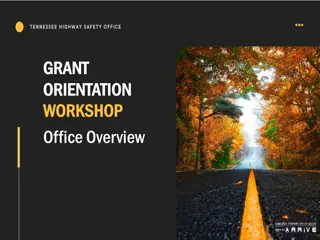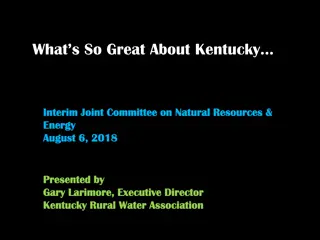Comparison of Kentucky Highway Fatality Rates Across Multiple States
Analysis reveals Kentucky's highway fatality rates in comparison to other states over the years 2005, 2013, 2014, and 2015. Data from the National Highway Traffic Safety Administration (NHTSA) shows variations in fatalities per 100 million vehicle miles traveled, positioning Kentucky among the states with differing rates. The comparison highlights fluctuations in Kentucky's highway safety performance relative to its counterparts during the specified years, offering insights into road safety trends and challenges in the state.
Download Presentation

Please find below an Image/Link to download the presentation.
The content on the website is provided AS IS for your information and personal use only. It may not be sold, licensed, or shared on other websites without obtaining consent from the author.If you encounter any issues during the download, it is possible that the publisher has removed the file from their server.
You are allowed to download the files provided on this website for personal or commercial use, subject to the condition that they are used lawfully. All files are the property of their respective owners.
The content on the website is provided AS IS for your information and personal use only. It may not be sold, licensed, or shared on other websites without obtaining consent from the author.
E N D
Presentation Transcript
Kentucky Compared to Other States 2005 Highway Fatality Rates by State (Fatalities per 100 Million Vehicle Miles Traveled) 1.Mississippi 2.32 18.Oklahoma 1.71 35.Colorado 1.26 2.Montana 2.26 19.North Dakota 1.62 36.New Hampshire 1.24 3.South Dakota 2.22 20.North Carolina 1.53 37.Ohio 1.20 4.South Carolina 2.21 21.Georgia 1.52 38.Virginia 1.18 5.Louisiana 2.14 22.Pennsylvania 1.50 39.Washington 1.17 6.Kentucky 2.08 23.Texas 1.50 40.Maine 1.13 7.Nevada 2.06 24.Alaska 1.45 41.Utah 1.12 8.Arkansas 2.05 25.Iowa 1.45 42.Maryland 1.09 9.New Mexico 2.04 26.Kansas 1.44 43.Michigan 1.09 10.Arizona 1.97 27.Nebraska 1.43 44.Rhode Island 1.05 11.Alabama 1.92 28.Delaware 1.40 45.New York 1.03 12.Wyoming 1.88 29.Hawaii 1.39 46.New Jersey 1.01 13.Idaho 1.85 30.Oregon 1.38 47.Minnesota 0.98 14.Missouri 1.83 31.Wisconsin 1.36 48.Vermont 0.95 15.West Virginia 1.82 32.California 1.32 49.Connecticut 0.88 16.Tennessee 1.79 33.Indiana 1.31 50.Massachusetts 0.80 17.Florida 1.75 34.Illinois 1.27 National Average =1.52 Source: National Highway Traffic Safety Administration (NHTSA)
Kentucky Compared to Other States 2013 Highway Fatality Rates by State (Fatalities per 100 Million Vehicle Miles Traveled) 1.Montana 1.90 18.North Carolina 1.23 35.Illinois 0.94 2.West Virginia 1.73 19.Pennsylvania 1.22 36.Oregon 0.93 3.Mississippi 1.58 20.Kansas 1.16 37.Wyoming 0.93 4.South Carolina 1.57 21.Missouri 1.09 38.New York 0.92 5.South Dakota 1.48 22.Nebraska 1.09 39.Virginia 0.92 6.Louisiana 1.47 23.Georgia 1.08 40.California 0.91 7.North Dakota 1.47 24.Nevada 1.06 41.Wisconsin 0.91 8.Arkansas 1.44 25.Delaware 1.06 42.Connecticut 0.89 9.Oklahoma 1.41 26.Alaska 1.05 43.Ohio 0.88 10.Arizona 1.40 27.New Hampshire 1.05 44.Rhode Island 0.84 11.Tennessee 1.40 28.Maine 1.03 45.Maryland 0.82 12.Texas 1.38 29.Colorado 1.02 46.Utah 0.81 13.Kentucky 1.36 30.Hawaii 1.01 47.Washington 0.76 14.Idaho 1.34 31.Michigan 1.00 48.New Jersey 0.73 15.Alabama 1.31 32.Indiana 1.00 49.Minnesota 0.68 16.Florida 1.25 33.Iowa 1.00 50.Massachusetts 0.58 17.New Mexico 1.24 34.Vermont 0.97 National Average =1.13 Source: National Highway Traffic Safety Administration (NHTSA)
Kentucky Compared to Other States 2014 Highway Fatality Rates by State (Fatalities per 100 Million Vehicle Miles Traveled) 1.South Carolina 1.65 18.Kansas 1.25 35.California 0.93 2.Wyoming 1.59 19.Florida 1.24 36.Maine 0.92 3.Montana 1.58 20.Arizona 1.23 37.Ohio 0.89 4.Mississippi 1.54 21.Pennsylvania 1.20 38.Illinois 0.88 5.Louisiana 1.53 22.North Carolina 1.19 39.Virginia 0.87 6.New Mexico 1.52 23.Idaho 1.15 40.Wisconsin 0.84 7.Alaska 1.50 24.Nebraska 1.15 41.New York 0.81 8.South Dakota 1.47 25.Nevada 1.15 42.Connecticut 0.80 9.Texas 1.45 26.Missouri 1.08 43.Washington 0.80 10.West Virginia 1.42 27.Georgia 1.04 44.Maryland 0.78 11.Oklahoma 1.40 28.Oregon 1.03 45.New Jersey 0.74 12.Kentucky 1.40 29.Iowa 1.03 46.New Hampshire 0.73 13.Arkansas 1.38 30.Colorado 1.00 47.Rhode Island 0.66 14.Tennessee 1.33 31.Indiana 0.94 48.Minnesota 0.63 15.Delaware 1.29 32.Hawaii 0.93 49.Vermont 0.62 16.North Dakota 1.28 33.Michigan 0.93 50.Massachusetts 0.62 17.Alabama 1.25 34.Utah 0.93 National Average =1.08 Source: National Highway Traffic Safety Administration (NHTSA)
Kentucky Compared to Other States 2015 Highway Fatality Rates by State (Fatalities per 100 Million Vehicle Miles Traveled) 1.South Carolina 1.89 18.Nevada 1.26 35.Iowa 0.96 2.Montana 1.81 19.Alabama 1.26 36.Illinois 0.95 3.Mississippi 1.70 20.Tennessee 1.25 37.Utah 0.94 4.Arkansas 1.58 21.Oregon 1.24 38.Washington 0.92 5.Louisiana 1.56 22.North Carolina 1.23 39.Wisconsin 0.91 6.Kentucky 1.56 23.Nebraska 1.22 40.Virginia 0.91 7.Wyoming 1.51 24.Missouri 1.21 41.Maryland 0.90 8.South Dakota 1.44 25.Georgia 1.21 42.Hawaii 0.90 9.Florida 1.42 26.Pennsylvania 1.19 43.New York 0.89 10.Texas 1.39 27.Kansas 1.13 44.New Hampshire 0.87 11.Arizona 1.38 28.New Mexico 1.09 45.Connecticut 0.85 12.West Virginia 1.35 29.Colorado 1.08 46.Vermont 0.78 13.Oklahoma 1.35 30.Maine 1.07 47.New Jersey 0.74 14.Delaware 1.32 31.Indiana 1.04 48.Minnesota 0.72 15.North Dakota 1.31 32.California 1.01 49.Massachusetts 0.58 16.Idaho 1.30 33.Michigan 0.99 50.Rhode Island 0.57 17.Alaska 1.29 34.Ohio 0.98 National Average =1.15 Source: National Highway Traffic Safety Administration (NHTSA)
Kentucky Compared to Other States 2016 Highway Fatality Rates by State (Fatalities per 100 Million Vehicle Miles Traveled) 1.South Carolina 1.88 18.Oregon 1.32 35.California 0.99 2.Kentucky 1.69 19.Georgia 1.29 36.Illinois 0.99 3.Alaska 1.67 20.North Carolina 1.26 37.Indiana 0.99 4.Mississippi 1.63 21.Iowa 1.25 38.Ohio 0.95 5.Louisiana 1.53 22.Missouri 1.25 39.Wisconsin 0.95 6.New Mexico 1.53 23.Nevada 1.21 40.Utah 0.94 7.Arkansas 1.51 24.South Dakota 1.20 41.Connecticut 0.92 8.Alabama 1.49 25.Delaware 1.17 42.Virginia 0.90 9.Arizona 1.44 26.Wyoming 1.17 43.Washington 0.87 10.Florida 1.44 27.Pennsylvania 1.16 44.Maryland 0.86 11.Montana 1.44 28.Colorado 1.15 45.Vermont 0.85 12.Idaho 1.43 29.North Dakota 1.11 46.New Jersey 0.78 13.Texas 1.43 30.Maine 1.07 47.New York 0.75 14.Oklahoma 1.40 31.Nebraska 1.05 48.Massachusetts 0.66 15.West Virginia 1.37 32.Hawaii 1.03 49.Minnesota 0.66 16.Kansas 1.34 33.Michigan 1.02 50.Rhode Island 0.66 17.Tennessee 1.34 34.New Hampshire 1.01 National Average =1.18 Source: Insurance Institute for Highway Traffic Safety - PRELIMINARY
Rumble Strips Proven Countermeasure: Last year s HSIP Annual Evaluation shows that Rumble Strips in KY have an approximate Benefit to Cost Ratio of: 30:1 !!!!
How Do We Capitalize? Invest in More Rumble Strips!!! Installations need to be consistent and uniform, as much as possible As of the February 2017 Letting: Updated Rumble Strip Bid Items New Rumble Strip Sepia Drawings New Rumble Strip Supplemental Spec. (i.e. new language within Section 403)
Bid Items There are 3 types of Rumble Strips: 20458ES403 Centerline Rumble Strips LF 2697 Edgeline Rumble Strips LF 2696 Shoulder Rumble Strips LF
Sepia Drawings 7 new Sepia Drawings: http://transportation.ky.gov/Highway-Design/Pages/Sepias2016.aspx Sepia 002 Centerline Rumble Strips Sepia 003 Centerline Rumble Strips 4 inch Striping Sepia 004 Centerline Rumble Strips 6 inch Striping Sepia 005 Shoulder and Edgeline Rumble Strips Sepia 006 Edgeline Rumble Strip Details Two Lane Roadways Sepia 007 Shoulder Rumble Strip Details Two Lane Roadways Sepia 008 Rumble Strip Details Multi-Lane Roadways and Ramps
Supplemental Spec. Completely replaces the language in the following: Section 403.03.08 Old Spec. only discussed the construction of: Shoulder Rumble Strips and Pavement Texturing New Supplemental Spec. discusses the construction of: Centerline, Edgeline, and Shoulder Rumble Strips New Supplemental Spec. does NOT mention Pavement Texturing We no longer require the rolled-in rumble strips. We want a sawed rumble strip on every roadway that is 20 or wider Section 403.04.07 The Supplemental Spec. more thoroughly discusses what the Department will and will NOT measure for payment
Curves & HFS Common Question 1: My resurfacing project just covered up the High Friction Surface (HFS) along a curve. What do I do? Answer: Email Central Office HSIP staff the following info: County, Route, MP range, Date HFS was covered The new asphalt surface s Aggregate Type (A, B, or D) Whether or not the curve s superelevation was improved CO HSIP will update the HFS inventory info & monitor crash history
Curves & HFS Common Question 2: I m doing the estimate for a resurfacing project. A curve on the project has existing HFS. What do I do? Answer: Thoroughly check the existing superelevation of the curve AND the transitions into & out of the curve. Some of the curves in Kentucky have HFS because of: limited, or inconsistent, superelevation.
Curves & HFS Common Question 2: I m doing the estimate for a resurfacing project. A curve on the project has existing HFS. What do I do? Guidance: Thoroughly check = use a wheel and smart level to measure super every 50-100 ft and record measurements Consistent = existing super is within a 2% range (e.g. super between 3% - 5%)
Curves & HFS Common Question 2: I m doing the estimate for a resurfacing project. A curve on the project has existing HFS. What do I do? Answer: If the superelevation is found to need improvement: include quantities, notes, and details in the resurfacing proposal/estimate to improve the superelevation. This may eliminate the need for HFS in the future
Superelevation Improvement Common Question 3: Do you have any guidance on when to improve a curve s superelevation? Guidance: If the existing superelevation is in the wrong direction: ENORMOUS RED FLAG !! SUPERELEVATION IMPROVEMENT IS NEEDED
Superelevation Improvement Common Question 3: Do you have any guidance on when to improve a curve s superelevation? Guidance: If the existing superelevation is in the correct direction, but is less than 2%: RED FLAG !! SUPERELEVATION IMPROVEMENT IS NEEDED
Superelevation Improvement Common Question 3: Do you have any guidance on when to improve a curve s superelevation? Guidance: If the existing superelevation is in the correct direction, and has 2% - 4% cross slope: CONSIDER SUPERELEVATION IMPROVEMENT
Superelevation Improvement Common Question 3: Do you have any guidance on when to improve a curve s superelevation? Guidance: If the existing superelevation is in the correct direction, and has 4% (or better) cross slope: SUPERELEVATION IMPROVEMENT IS LIKELY NOT NEEDED
Superelevation Improvement Common Question 3: Do you have any guidance on when to improve a curve s superelevation? Guidance: If the existing superelevation is in the correct direction, and has more than 10% cross slope: CONSIDER REDUCINGTHE CURVE S SUPERELEVATION
Setting Up Super Improvements Common Question 4: What bid items, notes, details, etc. does HSIP usually include for superelevation improvements?
Setting Up Super Improvements Bid Items: Leveling & Wedging Asphalt Base Staking Quantities: Estimate TOTAL amount of asphalt material needed to achieve the desired superelevation. Make an educated guess on how much material should be Leveling & Wedging and how much should be Asphalt Base (e.g. 30% L & W 70% Asph Base)
Setting Up Super Improvements Notes: Superelevation Improvements. The intent of this work is to construct a consistent pavement cross slope through the identified curve(s). The Contractor will need to utilize Leveling & Wedging and/or Asphalt Base in order to achieve the desired superelevation improvements at the identified location(s). In areas where the superelevation improvement will only require adding 1-3 inches of additional pavement depth, Leveling & Wedging PG64-22 will be required. In areas where the superelevation improvement will require 3 or more inches of additional pavement depth, Asphalt Base 1.00D PG 64-22 will be required. The Superelevation Improvement Summary lists the estimated quantities of Asphalt Base and Leveling & Wedging for each curve; however, the Engineer will make the final determination as to which bid items will be required at each superelevation improvement area, as well as the appropriate lift thicknesses and number of lifts, based on the existing conditions encountered at the time of construction.
Setting Up Super Improvements Notes: As a result of the superelevation improvements, the roadside shoulders, fill slopes, and/or ditches will have to be modified to match the final pavement elevations and tie in with the existing ground lines. The bid item Ditching & Shouldering has been included for these roadside modifications. Refer to the detail sheet titled: Ditching & Shouldering and Embankment Benching Details. NOTE: Some field adjustments of the proposed shoulder width, fill slope, ditch, and/or superelevation improvement may be required. The resulting shoulder and fill slope grading is intended to occur within Right-of-Way and NOT disturb any sensitive obstructions (i.e. fences, buildings, utility poles, etc.). Superelevation improvements with sensitive obstructions along the roadside shall still require the roadside shoulder and fill slope to be modified, but the fill slope may have to be constructed steeper than what is shown on the Superelevation Typical Section.
Setting Up Super Improvements Notes: The desire of the Department is to construct the new fill slopes at 3:1 or flatter. When a fill slope needs to be constructed steeper than 3:1 to remain within Right-of-Way or not impact a sensitive obstruction, and the existing fill slope is steeper than 3:1, then the new fill slope can be constructed steeper than 3:1, but the new fill slope shall not be constructed steeper than the existing fill slope. If a desired superelevation improvement will result in the new fill slope having to be graded steeper than the existing fill slope in order to remain within Right-of-Way or not impact a sensitive obstruction, then the superelevation rate should be modified (reduced) in order to reduce the final change in pavement edge elevation, thereby reducing the height of the new fill slope grading, and allowing for a flatter fill slope.
Setting Up Super Improvements Staking Note: Establish pavement superelevation cross slopes, runout and runoff transitions and tapers, and determine the necessary change in pavement edge elevation along the curve and the transitions leading into and out of the curve to achieve the proposed superelevation rates, runoffs, and runouts. Prior to starting paving operations, verify the proposed Ditching & Shouldering can be constructed so that the new roadside is flush with the new pavement edge elevations and the new toe of slope, or top of cut, will remain within the existing Right-of-Way and/or not impact a sensitive obstruction. With the approval of the Engineer, adjust/reduce the proposed superelevation rate of a curve if the new edge of pavement elevation will cause the new roadside grading to extend beyond the Right-of-Way and/or impact a sensitive obstruction. Also, prior to starting paving operations, submit to the Engineer and obtain his/her approval of the number of lifts, each lift s thickness, and the asphalt material type to achieve the superelevation improvement. Ensure positive drainage upon completion of the work.
Setting Up Super Improvements Details: Superelevation Typical Section:
Setting Up Super Improvements Details: Ditching & Shouldering and Embankment Bench Detail Sheet
Setting Up Super Improvements If you would like a copy of any of these Notes or Details, email Central Office HSIP: Mike Vaughn Mike.Vaughn@ky.gov Nathan Ridgway Nathan.Ridgway@ky.gov David Durman David.Durman@ky.gov























